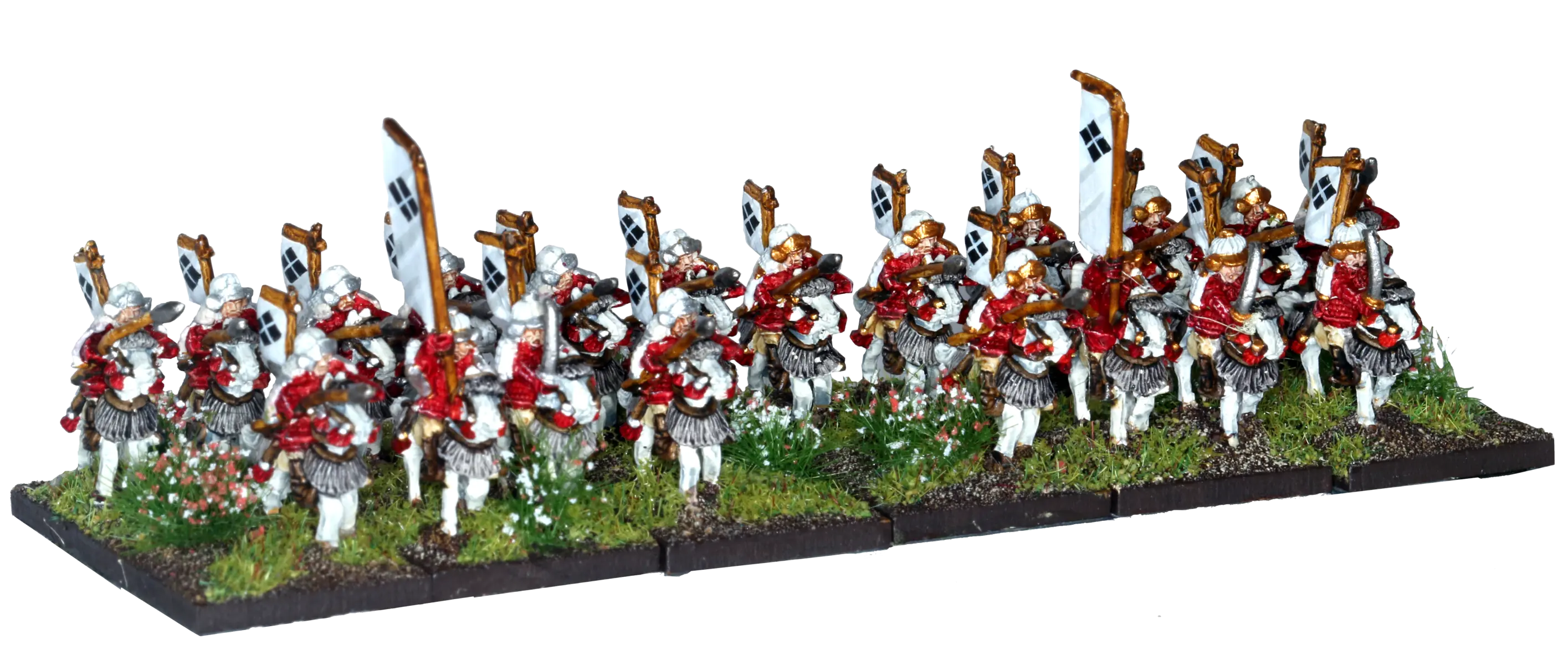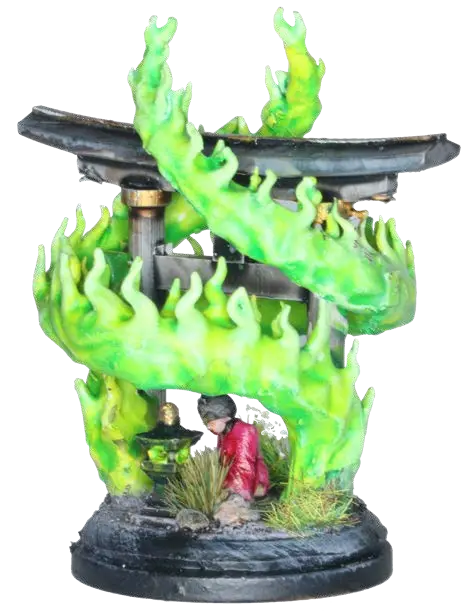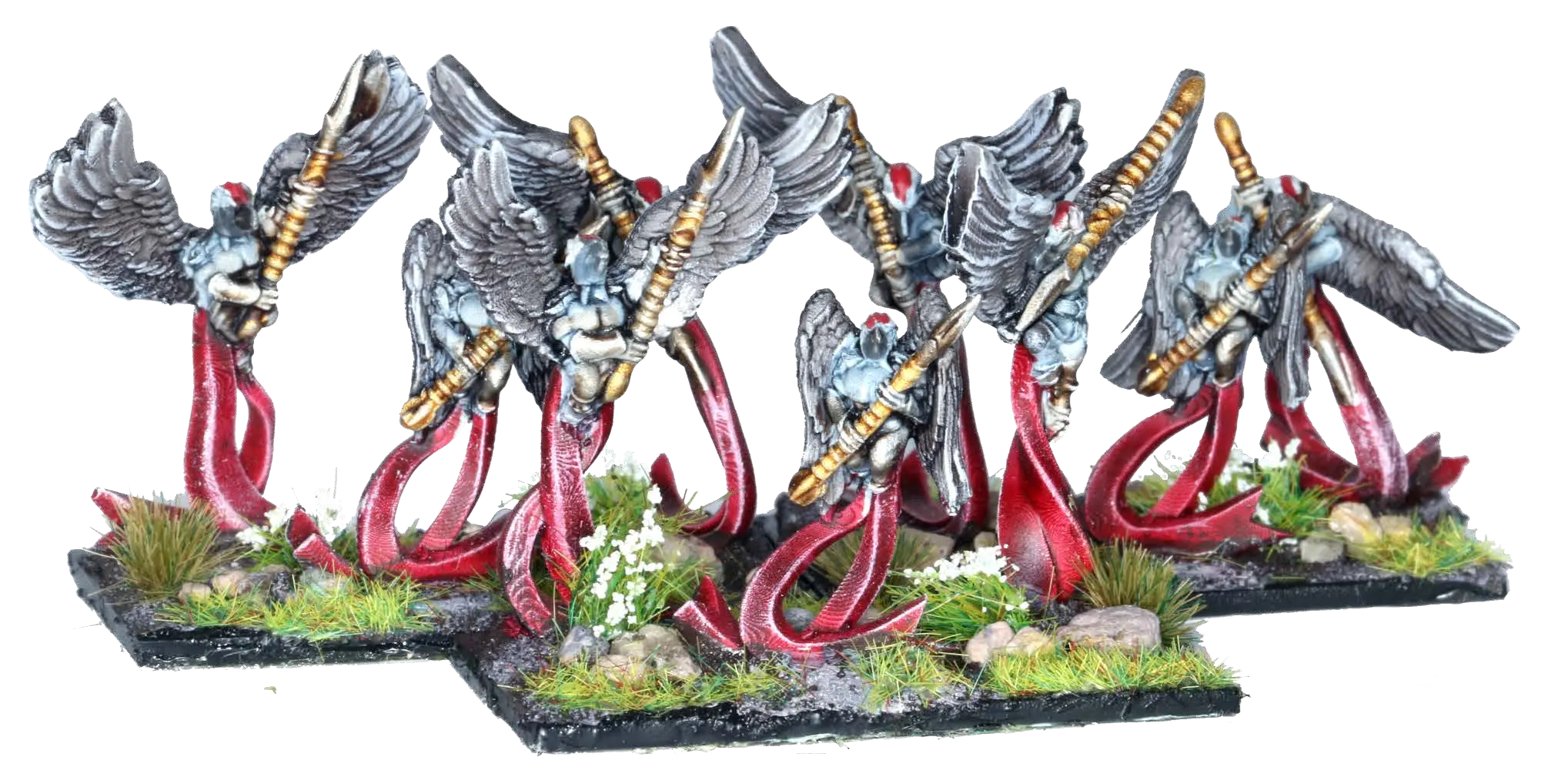Nippon
 Far to the east of the Old World, even farther east than the fabled lands of Cathay, lie the islands of the Nipponese archipelago. Inhabited by a sophisticated but stoic nation of humans, where warfare is common and honour is everything.
Far to the east of the Old World, even farther east than the fabled lands of Cathay, lie the islands of the Nipponese archipelago. Inhabited by a sophisticated but stoic nation of humans, where warfare is common and honour is everything.
Nipponese society is highly structured and is based on feudal rule in a strict hierarchy from the Emperor, a semi-divine being who is rarely seen in public, down to the lowest peasants who tend the fields. There are many similarities between Nippon and Bretonnian society, though Daimyo – the Nippon Lords – are even harsher and uncaring towards anyone they consider to be their inferior than their Bretonnian counterparts. The strongest Daimyo vie for the position of Shogun: supreme military leader of Nippon, answerable only to the Emperor himself.
Each Daimyo maintains a standing army to defend his lands from neighbouring warlords and pirate raids. The army is mainly composed of Samurai, noble warriors who devote their lives to training in the art of war. The Samurai are supported by Ashigaru, soldiers drawn from his common subjects and given basic training and weaponry. More significant threats require several Daimyo to contribute forces to the Emperor’s army, under the command of the Shogun. Sometimes these armies include Mikata – warriors whom a Daimyo may employ outside of their retinue to bolster its strength. These warriors represent the Ronin, Temple Monks, and Junior Samurai. Armies sometimes include Ninja, clans of stealthy warriors, who specialise in all forms of espionage, deception, and covert warfare.
The Nipponese islands are located in the Northern hemisphere of the world, on the same latitude as Ulthuan but the opposite longitude. Many of the magical lines of power which were harnessed into the Great Vortex of the High Elves connect through the planet to Nippon, drawing magical energy away. Thus, the Winds of Magic are relatively thin in this part of the world, so wizards are few.
The Nipponese people are known as highly stoic people from whom expressions of emotion are rare. However, this repressed spiritual energy builds up until it manifests itself in a physical form. Many Nipponese mythical creatures are a natural byproduct of unseen human hopes and fears which can manifest in physical form when emotions are strong or prolonged. Smaller creatures are often a nuisance in daily life and are exorcised before they become too troublesome by a Shugenja, who sometimes draws energy from a magical shrine to assist him in the process.
Larger creatures tend to congregate near temples, drawn by the concentration of emotion and energy at these holy sites. In times of war, they become more common and the Shugenja of the temple can marshal them into useful fighting forces but their control over them is limited and they can disappear back into the magical ether from which they came. The most common forms are Oni (ogres) who are powerful fighters. If the Shugenja coalesces the energies together onto a physical object such as the Komainu (lion-dog statues which guard temple entrances), the object becomes a living creature. Larger creatures can be created if the temple’s Abbott coalesces the energies into larger objects. These colourful creatures bolster the Nipponese army against significant threats facing the whole nation. However the magical energy used to bind them can prove unstable under battlefield conditions.

Nippon army selector
| Troupe | Type | Attaques | Points de Vie (PV) | Armure | Commandement (Cdt) | Taille d’unité | Points par unités | Min/max | Spécial |
|---|---|---|---|---|---|---|---|---|---|
Ashigaru |
Infanterie |
3 |
3 |
6+ |
– |
3 |
45 |
1/– |
– |
Ashigaru Bowmen |
Infanterie |
3/1 |
3 |
– |
– |
3 |
55 |
–/– |
– |
Ashigaru Teppo |
Infanterie |
3/1 |
3 |
– |
– |
3 |
65 |
–/– |
|
Samurai |
Infanterie |
4 |
3 |
5+ |
– |
3 |
80 |
2/4 |
|
Mikata (Ronin & Monks) |
Infanterie |
5 |
3 |
– |
– |
3 |
70 |
–/2 |
|
Ninja |
Infanterie |
3/1 |
3 |
6+ |
– |
3 |
60 |
–/2 |
|
Oni |
Infanterie |
4 |
4 |
5+ |
– |
3 |
110 |
–/1 |
|
Samurai Cavalry |
Cavalerie |
4 |
3 |
5+ |
– |
3 |
110 |
–/3 |
|
Komainu |
Cavalerie |
2 |
3 |
– |
– |
3 |
40 |
–/3 |
|
Tengu |
Monstre |
2 |
3 |
5+ |
– |
3 |
80 |
–/1 |
|
|
|||||||||
Shogun |
Général |
+2 |
– |
– |
9 |
1 |
125 |
1 |
|
Daimyo |
Héros |
+1 |
– |
– |
8 |
1 |
80 |
–/1 |
– |
Shugenja |
Héros |
+1 |
– |
– |
8 |
1 |
90 |
–/1 |
|
Tatsu |
Monstre monté |
+2 |
– |
– |
– |
– |
+80 |
–/1 |
|
Shrine |
Spécial |
+0 |
– |
– |
– |
– |
+50 |
0–1 |
Règles Spéciales
Règles de l’Armée
- Honour and Duty
-
A Nipponese army mustered for war is a force unlike any other. Values of honour and duty are so ingrained in the culture of Nipponese society that they will stick around in a fight when many others would leave in disgrace. To represent this, a Nippon army adds 1 to the number of units that must be lost before the army will withdraw. For example – an army of 16 units will normally withdraw once eight units are destroyed – with Nippon, the army will not withdraw until nine units are destroyed.

Règles Spéciales
- 1. Ashigaru Teppo
-
These units use black powder handguns. Their projectiles can pierce armour far easier than an arrow. Therefore, units hit by Ashigaru Teppo get a −1 penalty for their armour rolls.
- 2. Bushido
-
Samurai live their lives by a strict code of honour and ideals. The troops do not like losing face, so they cannot use Initiative to evade and they roll 1 less dice for drive back.
- 3. Mikata
-
A unit of Mikata will always use its initiative to charge an enemy if possible and cannot be given orders instead. They will never use their initiative to evade. They can’t be driven back by shooting and do not roll for drive backs. If victorious in combat, they must pursue or advance where possible.
Mikata are unaffected by enemies that cause terror in combat, so they do not suffer the usual −1 Attack modifier.
- 4. Ninja
-
Les Ninjas ont une portée de tir de 15cm et une vision à 360° - c’est-à-dire que les socles de l’unité peuvent tracer une ligne de vue depuis n’importe quel bord de leur socle, ceci afin d’éviter ou de tirer, incluant le tir sur les ennemis en charge. Notez que l’unité a tout de même besoin d’avoir une Ligne de Vue depuis son bord avant pour charger un ennemi.
Une unité de Ninja n’a pas à être déployée au début de la bataille si le joueur le désire. À la place, l’unité peut s’infiltrer sur le champ de bataille une fois la partie commencée. Pour infiltrer une unité, le joueur Nippon désigne le point où il veut la faire apparaître et doit lui donner un ordre d’infiltration avec l’un de ses personnages. Le personnage ne tient pas compte des portées d’ordre pour donner l’ordre d’infiltration : on considère que sa portée d’ordre s’étend à l’ensemble du champ de bataille pour ce qui est de donner un tel ordre. Considérez que l’ordre est donné au point où l’unité doit apparaître, et appliquez tous les modificateurs de portée, de proximité de l’ennemi, etc. mais ignorez les pénalités dues au terrain difficile. Le point d’apparition de l’unité doit être situé en terrain dense ou sur un bord de table n’étant pas celui du joueur adverse. Si l’ordre d’infiltration est donné avec succès, placez un socle de l’unité sur le point indiqué et positionnez les autres en formation autour de celui-ci. L’unité infiltrée ne peut pas être placée de façon à toucher l’ennemi. Une fois qu’elle est déployée, elle peut recevoir des ordres du personnage qui a donné l’ordre d’infiltration, si celui-ci se trouve à portée d’ordre habituelle : on considère qu’elle a utilisé son premier ordre pour se déployer. Si l’ordre d’infiltration est un échec, l’unité n’est pas déployée et ne peut pas s’infiltrer lors de ce tour. Elle pourra essayer de nouveau lors d’un tour suivant, au même endroit ou en un autre lieu.
Ninjas ignore penalties for Dense Terrain. Ninja count as Gutter Runners for the purpose of Scout Rules.
- 5. Temple Daemons
-
Temple Daemons are immune to terror and cannot be given magic items. They also suffer from Daemonic Instability. At the start of the Nippon player’s own Command phase, before making any initiatives moves, all friendly Daemon units that have taken at least 1 stand as casualty must make a ‘Daemonic Instability’ test. Roll a D6. If the unit has lost 2 stands deduct 1 from the roll.
0–1
One stand is destroyed – the daemons fade away and are absorbed back into the heaven from which they came. Remove one stand from play. If a character is with the unit and the last stand is removed the character is destroyed too.
2–3
The unit becomes confused – if not already confused the stand becomes confused as it is torn between this world and the next.
4–5
No effect – unless the unit is confused in which case it ceases to be confused as it is favoured with the invigorating power of the Temple.
6
The unit regains one stand. The regained stand is placed in formation with the rest of the unit. If it is impossible to position the stand in formation with its unit then the stand cannot be added.
- 6. Komainu
-
Si l’unité charge un ennemi à découvert, elle reçoit un bonus de +1 Attaque, comme les chars et les monstres.
Komainu are affected by Instability and Immune to Terror like other Temple Daemons.
- 7. Tengu
-
Tengu can fly.
They are an exception to the normal conventions for basing monsters in that they face the long edge of the stand in the same way as infantry rather than the short edge as most other monsters.
Tengu are affected by Instability and Immune to Terror like other Temple Daemons.
- 8. Shogun
-
If a Nippon Hero (Daimyo or Shugenja, not the Shogun) rolls a double 6 when issuing orders, the player must roll on the Blunder table with a −1 penalty on the result. If the table indicates a “You must be crazy” result, the −1 Command penalty must be applied to a Samurai or Samurai cavalry unit if a unit of these troops was being ordered or was in the brigade being ordered. If there is more than one of these units present, the Nippon player may choose which is affected.
- 9. Shugenja
-
If an enemy wizard who is within 50cm of the Shugenja casts a spell the Shugenja can attempt to dispel it. Note that it does not matter what the spell is or where it is cast, the Shugenja can try to dispel it so long as the caster is with 50cm.
To determine if this works, roll a D6. On the score of 4, 5 or 6 the Shugenja has succeeded and the spell doesn’t work, it is dispelled by the Shugenja’s defiant efforts. If he fails, then the Shugenja’s efforts come to nothing and the spell works as normal. A Shugenja can attempt to anti-magic any number of spells in a turn, but only one attempt can be made to anti-magic any individual spell – even if the army includes more than one Shugenja and several are in range of the enemy wizard.
The Shugenja adds +1 to any rolls on the Daemonic Instability table if he is within 20cm of the affected Daemon unit. This benefit only applies when rolling on the Daemonic Instability table for friendly units.
Shugenjas may take a Dispel scroll.
- 10. Tatsu
-
Generals and Heroes can ride Tatsu, a kind of dragon native to Nippon.
Tatsu can fly and cause terror in their enemies.
An extra +2 Attacks are added to those of its rider.
- 11. Shrine
-
The army can only include a single Shrine and it is incorporated onto the stand of a Shugenja.
If a Shugenja stand includes the Shrine, once per battle he can add +1 to his dice roll when he attempts to dispel enemy magic spells using the Shrine’s anti-magic ability (see Shugenja).
In addition, the Shugenja can invoke the gods using the Shrine during the Shooting phase of his own turn. The shrine’s invocation fills the Nippon army with even greater resolve! Roll a D6. On the score of a 4, 5 or 6 all Nippon units within 20cm of the Shugenja are unaffected by Terror until the start of the Nippon player’s next turn. On a roll of less than 4 there is no effect.
